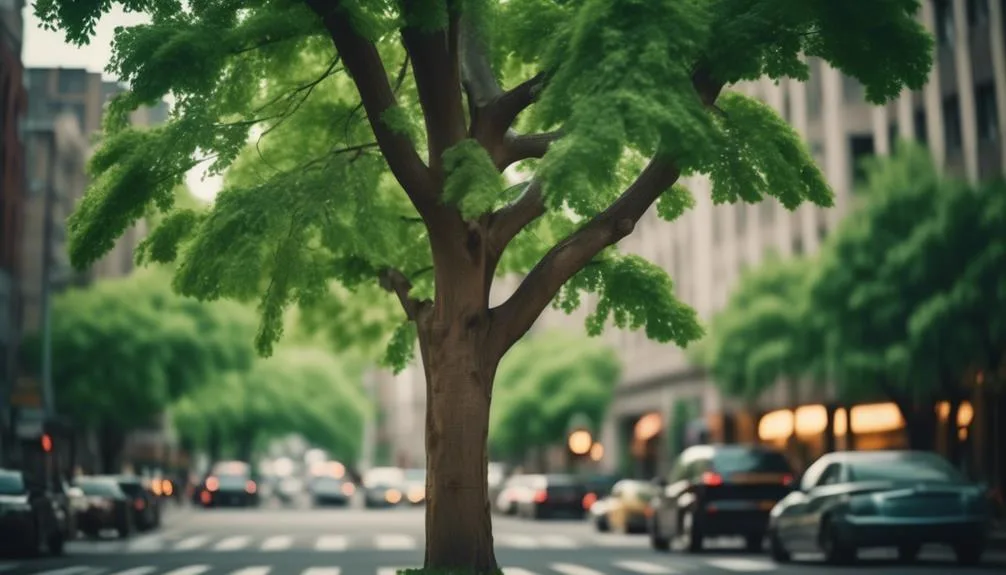Can Elm Trees Thrive in Urban Areas?
Urban greenery faces challenges, prompting curiosity about elm trees' survival in such environments. Let's explore the resilience of these majestic trees amidst urban complexities.
What sets them apart, and can they adapt? We'll examine the potential success of elm trees in urban landscapes and ponder their future.
Elm Tree Characteristics
Elm trees, known for their graceful, arching branches and serrated leaves, are popular choices for urban landscapes due to their resilience and adaptability to various environmental conditions.
These trees have a remarkable urban adaptation capacity, thriving in the midst of pollution, compacted soil, and limited space. Their deep root systems enable them to withstand urban challenges such as drought and air pollution.
Elm trees exhibit exceptional resilience, often rebounding from environmental stressors and diseases, making them ideal for urban settings. Their ability to purify the air and provide shade further enhances their appeal in urban environments.
With their elegant appearance and ability to thrive in challenging conditions, elm trees make a valuable addition to any urban landscape, contributing to the beauty and sustainability of cities.
Urban Environmental Challenges
Amidst the bustling concrete jungles of urban areas, trees face a myriad of environmental challenges that can impact their health and longevity.
Pollution from vehicles and industrial activities can have a detrimental impact on the overall well-being of elm trees. The high levels of pollutants such as nitrogen dioxide and sulfur dioxide can lead to leaf damage, reduced photosynthesis, and overall stunted growth.
Additionally, soil compaction, a common issue in urban environments due to heavy foot traffic and construction, can restrict the flow of water, air, and nutrients to the tree's roots, leading to poor growth and increased susceptibility to diseases.
It's crucial for urban planners and arborists to address these challenges through strategic planting, proper soil management, and pollution mitigation efforts to ensure the survival of elm trees in city landscapes.
Adaptation Strategies for Elm Trees
Facing the environmental challenges in urban areas, elm trees require adaptation strategies to thrive and withstand the detrimental impacts of pollution and soil compaction. To ensure their survival and health in urban environments, consider the following strategies:
- Pruning Techniques: Regular pruning helps elm trees maintain a balanced canopy, reducing stress and promoting overall tree health.
- Soil Aeration: Implementing techniques such as vertical mulching and air spading can improve soil aeration, allowing elm tree roots to access essential nutrients and water.
- Root Development: Encouraging deep root development through proper watering and mulching techniques can help elm trees better withstand soil compaction and drought conditions.
- Integrated Pest Management: Implementing holistic pest control methods can protect elm trees from insect infestations without relying solely on chemical interventions.
Success Stories of Elm Trees in Urban Areas
Thriving in the midst of urban challenges, elm trees have demonstrated remarkable resilience and success in various city environments. Despite the obstacles posed by urban growth patterns, many cities have witnessed the triumph of elm trees.
In Chicago, for example, the success of the disease-resistant American elm cultivars has been notable. These elms have flourished along the city streets, adding a touch of natural beauty to the urban landscape.
Additionally, in New York City, the Princeton and Valley Forge elm varieties have shown exceptional resilience, withstanding the harsh conditions of the city environment. Their ability to thrive amidst pollution, compacted soil, and limited space has made them a success story in urban forestry.
Elm trees continue to prove that with the right care and attention, they can't only survive but also thrive in urban areas.
Future Prospects for Elm Trees in Urban Environments
The success of disease-resistant American elm cultivars in urban areas sets the stage for exploring the future prospects of elm trees in city environments. With the looming challenges of urban pollution and climate change, the resilience of tree species becomes a critical factor in ensuring their survival in urban settings.
The future prospects for elm trees in urban environments are influenced by several key factors:
- Tree Species Diversity: The integration of diverse elm species can enhance resilience against urban pollution and climate variability.
- Adaptation Strategies: Implementing adaptive strategies to mitigate the impact of climate change on elm trees.
- Urban Planning: Incorporating elm-friendly urban planning practices to create suitable habitats for these trees.
- Community Engagement: Involving local communities in the preservation and care of elm trees to foster a sense of ownership and stewardship.
These factors will play a crucial role in determining the long-term prospects of elm trees in urban environments.
Conclusion
In embracing urban challenges, elm trees have shown remarkable resilience, thriving in cities worldwide. By understanding and addressing their needs, we secure a promising future for these iconic trees in our urban landscapes.
How might our efforts to support elm trees inspire a more sustainable coexistence with nature in our cities?

My interest in trees started when I first saw the giant sequoias in Yosemite.
I was a teenager then, and I remember thinking, “I need to learn more about this.”
That moment stuck with me.
A few years later, I went on to study forestry at Michigan Tech.
Since graduating, I’ve worked in a mix of hands-on tree care and community education.
I’ve spent over ten years helping people understand how to plant, maintain, and protect the trees in their neighborhoods.
I don’t see trees as just part of the landscape.
They are living things that make a real difference in our daily lives.
